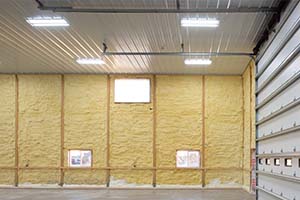Building Construction | Building Tips | Post Frame Homes
4 Essential Must-Haves for Your Barndominium
Nettie joined the FBi Marketing team in 2022 as the Marketing Content Creator. Nettie grew up just outside of Des Moines, IA. In 2016, she received her BS in Agriculture Communications from Iowa State University. Upon graduation, she has worked in agriculture sales and marketing. She moved to Indiana in 2020. Outside of work, Nettie enjoys quilting, crocheting, crafting, canning, gardening, fishing, and hunting. She is married and enjoys spending time with her husband and dog.
It is easy to get swooned into the beauty of barndominiums. You might daydream of rocking in a chair on a wrap-around porch with cedar columns, looking out at your land, and watching the sunset.
While we can all dream of the cool features on the exterior and interior of a pole barn home, the reality is there are four keys to building safe living quarters that all barndominiums should include.
When building any shelter, determining how you will control the temperature and moisture is essential to creating a warm and safe environment.
In this blog, we will dive into the four must-haves all post-frame homes should include. To learn more about the barndominium building process, download our free Ultimate Guide to Building a Barndominium.
4 Barndominium Must-Haves
1) Protection from Water
 Roofing & Siding
Roofing & Siding
When it rains, the last thing you need is water to come inside your home. To help prevent this from happening, ensure you have a properly designed roof with quality materials.
Selecting a post-frame builder with in-house engineers, such as FBi Buildings, benefits you. Our engineers will design and build a post-frame structure that will last and meet or exceed standards.
 Most customers choose a metal roof, but pole barn homes can also have a shingled roof. Furthermore, most customers choose our metal for siding, but you can select brick, stone, or vinyl siding.
Most customers choose a metal roof, but pole barn homes can also have a shingled roof. Furthermore, most customers choose our metal for siding, but you can select brick, stone, or vinyl siding.
Like a stick-built home, the exterior material provides protection and enhances the overall aesthetics. To enhance your pole building, consider adding stone or metal wainscoting to your project to enhance your pole building.
Window Flashing
 Regarding exterior materials, ensure that your windows and doors are trimmed with flashing. This thin metal around each window greatly protects the window and window frame from water damage, structural damage, mold, and wood rot.
Regarding exterior materials, ensure that your windows and doors are trimmed with flashing. This thin metal around each window greatly protects the window and window frame from water damage, structural damage, mold, and wood rot.
Building Wrap
Next, consider adding building wrap. This protective layer is installed between the metal siding and the wood framing. It protects from air leaks, water, and the elements. It is not a big added cost to your project; most customers say this is one upgrade worth doing!
Plus, building wrap helps restrict airflow that may slip in between the metal and the wall cavity. This makes your building more energy efficient, thus saving you money.
Drainage
Proper site preparation is the cornerstone of condensation control. The objective is to set your building on a solid surface and to establish the right finished floor elevation (FFE) so your structure stays high and dry.
Proper drainage helps you manage the water flow that’ll come off the roof and send it away from the structure to a location of your choice. Many customers run their downspouts into tiles that drain into remote ditches or ponds. Wherever you go with it, the key is to channel rainwater runoff away from your building.
2) Air Control
The Midwest experiences a range of temperatures, from the sweltering summer heat to the blustery cold winter nights. Because of that, you will want to ensure you have a heating and cooling system in place that is properly sized for your pole barn.
Pole barns are energy efficient, but air can still be exchanged from the outdoors and vice versa. When building a pole barn home, you want to eliminate this exchange since it can also allow moisture, dust, and even mice to get in if not properly sealed. Below, we outline three options to reduce air exchange and the pros and cons of each.
Zip System
The Zip System uses all-in-one panels for sheathing that, when adhered together correctly—using tape or liquid sealants—create a highly rated R-value barrier that protects your home. Layered with foam insulation, these panels provide thermal, air, and water resistance in one application.
Pros:
- Consolidated Workflow Saves Money
- No building wrap is required
- Durable Weather Barrier
- Energy-Efficient
- Sustainable Design
Cons:
- Higher Initial Investment
- Every nail and fastener that creates a panel hole will make a potential source of water or air leakage.
 Building Wrap + Tape
Building Wrap + Tape
Building wrap is a popular option for keeping the elements out of new homes and post-frame construction. Wrap and tape can also be used on post-frame buildings to help prevent air and water leaks, keep out drafts, and protect insulation. The tape is added to seal, but keep in mind that nails may still puncture and not seal all the way.
Pros:
- Prevents air & water leaks
Cons:
- Where nails puncture, they will not fully seal from water & air leaks
 Building Wrap + Spray Foam
Building Wrap + Spray Foam
Spray foam has gained popularity due to its R-value; mold and mildew do not grow on it, creating an impenetrable, tight seal. The building wrap will ensure an added layer between the dust, pollen, or moisture that could get in. This is the most expensive option of the three.
If you are considering spray foaming your building, building wrap will help protect your metal.
For example, in a couple of years, you notice your metal has multiple rock dings from the mower; the beauty of wainscoting is we can easily swap out panels and make your building look like new again. However, if you have spray foam without building wrap, the foam will have to be scraped off, which makes the replacement more difficult.
Pros:
- Air leakage is virtually eliminated
- An air-tight seal prevents heat loss
- Home energy efficiency is assured
- Seasonal energy bills are lowered
- Ideal for attics, roofs, walls, floors
- Higher R-value than other installs
- Moisture accumulation is reduced
- All awkward spaces are sealed up
- Air drafts are effectively eradicated
- Cost can be two to three times higher than other insulation options
3) Thermal Transfer
Thermal transfer describes the transfer of air from outdoors. To reduce this transfer, selecting quality insulation will help maintain an air-tight, climate-controlled space.
Wall Cavity
Some popular insulation options include spray foam, batt insulation, vinyl back, and rigid board insulation. And while building wrap isn't considered insulation, building wrap is an optional convection barrier.
Attic
I nsulation is important from the ground up. As we all know, heat rises, and excess heat and moisture can cause damage. That is why it is important to plan your attic space properly.
nsulation is important from the ground up. As we all know, heat rises, and excess heat and moisture can cause damage. That is why it is important to plan your attic space properly.
Attic ventilation helps maintain a comfortable temperature and saves energy year-round. It also protects your home's structure and materials from damage caused by excess heat and moisture.
All FBi Buildings pole barns include a vented ridge cap to allow excess heat to escape. Installing 12" or 24" overhangs on end and side walls to aid in the air exchange will draw in fresh air.
 Flat Ceiling
Flat Ceiling
Deciding on your ceiling type is fundamental since it may limit the type of insulation you use. A flat ceiling with blown insulation is the most popular choice.
When blown insulation is installed correctly, the loose fill provides an airtight finish between the trusses' ceiling joists and bottom chords. According to Energy-Star, the recommended level for attics is R-38 (10 to 14 inches).
However, with blown-in insulation, you need to factor in ventilation to allow moisture to escape. Most FBi Building pole barns include a vented ridge that is installed end-to-end at the roof's peak. The vented ride allows excess air and moisture to escape.
A 12" or 24" overhang with a vented soffit not only adds to the overall athletic appearance of your building but also plays a vital role in allowing fresh air to enter and push excess heat and moisture out.
 Vaulted ceiling
Vaulted ceiling
Vaulted trusses allow you to have high ceilings and make rooms feel larger. However, your insulation type is limited to spray foam, batt insulation, or a ridge foam board. Spray foam is a great insulation option, but it can cost two to three times more than other options.
Having the additional volume will also need to be factored into the volume your HVAC system will need to heat /cool.
4) Vapor Control
 Consider how breathing, taking showers, and cooking all create excess vapor. And don't forget those hot, humid summer days. If your air conditioning isn't removing excess moisture, you are bound to end up with mold and mildew.
Consider how breathing, taking showers, and cooking all create excess vapor. And don't forget those hot, humid summer days. If your air conditioning isn't removing excess moisture, you are bound to end up with mold and mildew.
You can run a dehumidifier or add one to your AC unit. Also, consider adding house plants. Some houseplants, like English ivy, Boston fern, and peace lily, can help dehumidify the air.
Fungus, such as mold, prefer warm, moist areas with stale, non-moving air. To keep vapor under control, you will need to increase airflow. You can accomplish this by opening windows, planning exhaust fans in bathrooms, adding a vented hood in the kitchen, and installing ceiling fans.
It is key to add ventilation that removes the warm, moist air out and not into your attic. Pole barn ventilation can be accomplished by adding fans, opening windows and doors, installing cupolas with fans, and mechanical ventilation.
Which Barndominium Must Haves Will You Pick?
Proper ventilation is essential for maintaining a comfortable and healthy living environment in your barndominium. In addition to increasing airflow, it is important to consider insulation options to regulate temperature and reduce energy costs.
Spray foam insulation and building wrap can provide a tight seal, while a zip system offers a more efficient way to control air and moisture. By choosing the right combination of ventilation and insulation, you can create functional and comfortable space for you and your family.
Ready to get started? Call us at (800) 552-2981 or click the button below for a free pole barn estimate.
Have more questions about pole barn must-haves not covered in this article? Please contact FBi Buildings at 1.800.552.2981 or click here to email us. If you are ready to get a price, click here to request a quote and a member of our sales team will call you.




